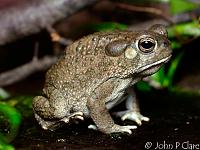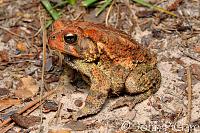Toad Care Basics - Care of Bufo, Anaxyrus, Spea, Alytes, and other Ground-Dwelling Toads
by John P. Clare
Caring for toads in captivity - as pets or otherwise. This article covers most if not all species of US and European ground dwelling toads, including the multitude of Bufo/Anaxyrus in the US and Europe, and the Spadefoot toads. This is aimed at people who have decided to keep a toad but know little about them and want to give them good basic care in a hurry. This seems to happen a lot. The info presented here is not intended for fire-belly toads (Bombina).
Photos ©John P. Clare / FrogForum.net
Texas Toad, Bufo speciosus East Texas Toad, Bufo woodhousii
velatusCouch's Spadefood Toad,
Scaphiopus couchii
Container/Vivarium/Terrarium (all the same thing):
- These toads live on the ground so you want more surface area than height.
- A rudimentary, cheap but very functional container is a 55 litre/58 quart plastic storage container sold in Walmart in the US, or anything similar elsewhere in the world. Make sure you pick up the lid when you buy the box (make sure the lid snaps on securely so that the toads can't escape!). Such a container could comfortably house at least 2 of any US or European species with the exception of adult Cane/Marine Toads and Colorado River/Sonoran Desert Toads - these guys are just too big to keep more than 2 adults in a container like this, and even that is pushing it.
- Alternatives: an old aquarium with a good lid, and for very temporary housing, a sturdy cardboard box.
- Punching some holes in the lid with a screw driver is good for ventilation. A more sophisticated approach is to cut a section out of the centre of the lid using a craft knife (box cutter) and then glue an over-sized piece of window mesh onto the lid over the hole using a hobby glue gun - this glue is safe enough once it's solid and cold - a quick rinse with water prior to using the lid is helpful.
Substrate (what stuff the toads will run around on or burrow in):
- Additive-free top soil or potting soil from a garden centre or hardware shop/store is ideal. You can use your garden's soil provided it has not had chemicals sprayed or added to it in at least 6 months.
- Coconut fibre (sold under various brand names as a compressed brick that you soak in a bucket of water overnight to expand).
- Very temporary: paper towl or newspaper - these foul very easily and do not provide a stable environment for your toads, so only use if absolutely necessary and only for a short time. Burrowing species (including most species of Bufonid west of the central US, many southern European/North African species, all spadefoots) will suffer a lot of stress after a day or two on a substrate into which they cannot burrow so bear this in mind - stress leads to disease. Paper towel contains bleaching agents, unless explicitly stated to not contain them - these can be harmful to toads and frogs.
- If you use a real substrate like top soil, provide at least 2 inches. Most of these toads burrow to some extent, some more so than others. This will make them feel more secure.
Hides/Cover:
- Halved hollow logs are great for this and are commonly sold in pet shops, or you can provide your own. There are artificial versions made of plastic that are very good too.
- Slabs of flat wood are good too - the toads will burrow underneath them.
- Plants will be uprooted and damaged so find robust species if you must use plants. Otherwise go with the artificial versions sold in pet shops and hobby shops.
- Some species like their own private space so give several hides if you have several toads. It's always good for a lone toad to give more than one hiding space too.
Food/Feeding:
- Most toads have a hard time eating earthworms so those are usually not on the menu for these guys.
- Crickets are a good staple - don't use wild caught ones because they pose a parasite risk and are often high in dangerous pesticides that can hurt or kill your toad. Suitable crickets are usually available from good pet shops and can be mail ordered online. If you've just found your toad, the chances are it won't eat right away so a 1-2 day mail order delivery of crickets is fine and should save you money over buying locally.
- Captive cultured cockroaches are excellent but are expensive unless you culture them yourself.
- If feeding crickets, make sure you gutload them first. This means you feed the crickets for at least a few hours, preferably a few days, prior to offering them to the toads. This increases the nutritional value of the crickets. A simple and cheap cricket food is tropical fish flakes. Commercial cricket diets are available too.
- Mealworms and Superworms are suitable food, depending on the size of your toad but it's best to go with smaller than bigger because the big ones can do damage with their biting jaws.
- If you have baby toads (called toadlets) you will need to offer fruit flies (captive cultured, not the wild kind - too messy) or pinhead or very small crickets.
- Outside of winter you can offer food every 2-3 days to adult or well grown juvenile toads. Toadlets should be fed daily. In winter, depending on how cold, the toads may not eat at all.
Temperature and Moisture:
- Outside of winter, if you don't know what kind of toad you have, a safe range for most American toad species is from 15-25 degrees C (that's 59-77 degrees F to Americans and old fashioned British people!). European species should be kept a little cooler unless you know the individual species' requirements.
- Don't keep in sunlight.
- Don't keep near heat sources unless you know that it is required by the toad species in question and the heating method is safe for amphibians.
- A water bowl is a good idea for all species - just put an inch (2.5 cm) or less of water in it, and it doesn't have to be big. It's a good idea to use dechlorinator (sold by pet shops and many supermarkets) to treat the water before you let the toads use it.
- Toads don't drink but they will sometimes soak in the water.
- A brief daily misting of water using a mister bottle does no harm.
- Toads generally like their homes a little drier than frogs, so don't go overboard with the misting.
Finally, from a pet point of view, most wild toads are quite nervous when first caught - give them time and don't expose them to loud noises and bright lights. Try interacting with them a little each day - take the lid off and have a look, feed them, etc. They don't like being touched or handled - these are definitely a "look, don't touch pet".
Good luck!










![Ireland [Ireland]](images/flags/Ireland.gif)






 Reply With Quote
Reply With Quote
